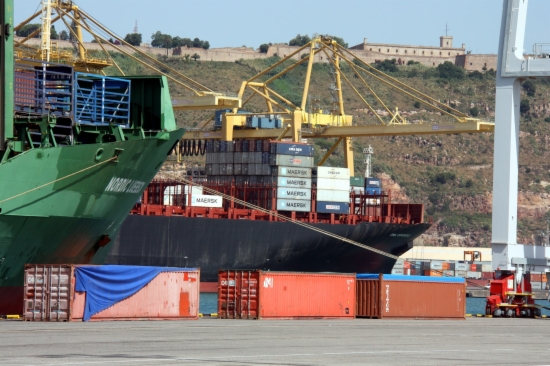The Port of Barcelona increased its container export levels by 12% during the first half of 2013 setting a new record
Container exports from the Port of Barcelona reached 276,566 TEU’s for the first half of this year, an increase of 12% on the same period of 2012. North Africa and the Far East have significantly grown as the destinations of exports from the Catalan harbour. Furthermore, among the highest exports are motor vehicles and bulk solid cargo such as cement. The Catalan Minister of Planning and Sustainability, Santi Vila, stressed the importance of the Port as an economic engine and the fact that it has changed itself from being an importer to an exporter of goods in recent years.

Barcelona (ACN).- The Port of Barcelona has seen an increase in its container export levels during the first half of 2012 and has reached 276,566 TEU’s (twenty-foot equivalent unit), which represents an increase of 12% on the same period of 2012. The growth has been due to a result of a rise in exports to countries outside Europe, especially those in North Africa (Morocco, Algeria and Tunisia) – which received 80,000 TEU’s – and the Far East (including China and Japan), with more than 60,000 TEU’s. After these geographic areas, the next ones receiving exports from Barcelona are the Eastern Mediterranean, the Black Sea, the Persian Gulf and the Arabian Sea. The Chairman of the Port Authority of Barcelona, Sixte Cambra, highlighted that after obtaining record exports in the first half of 2008, with 209,000 containers, there was a decline during the following year of 19%. However, the infrastructure recovered those levels in 2011 and since then it has significantly improved its figures. The Catalan Minister of Planning and Sustainability, Santi Vila, stressed how the port has been important for the Catalan economy during the current financial crisis. In addition, Vila also emphasised that the port has changed itself from being primarily an importer to an exporter of goods in the last few years.
700,000 cars will pass through the Catalan capital’s port
The export of motor vehicles has reached 200,000 units for the first half of 2013, compared to 184,000 in 2008. During 2009, the worst year of the economic crisis, this figure was 85,721. It is forecasted that the total number of vehicles that will pass through the Catalan port during 2013 will be 700,000. Part of this figure is due to vehicles that arrive at Barcelona in order to depart to another destination, a type of trade that has increased by 50%.
As for bulk solid cargo there has been an increase of 7% on last year. A total of 1.1 million tons were exported, compared to the 200,000 million tons in 2008. The transport of bulk liquid cargo was over 5.2 million tons and there has been a 69% growth in petrol transport, which exceeds 1 million tons.
Imports have been reduced by 2%, an improvement on last year’s 12% reduction
With regards to imports, they have been reducing in the last few years due to the poor internal demand in Spain because of the economic crisis. This year has seen a 2% reduction in the first half of 2013. However, June saw an increase of 5%, which could signal the beginning of an economic turnaround. The countries from which imports increased the most were Turkey, India, Vietnam, Chile and Russia.
Another positive figure in the port’s activity has been the increase in the transportation by rail of containers to and from the port, which has reached 66,942 TEU’s, a growth of 14% on the first half of 2012. 32% (30,000) of vehicles transported from or to the port have also travelled by train. Furthermore, bulk solid cargo brought to the port by train has risen to 208,410 tones, an increase of 22%, mostly salt and potassium minerals from Central Catalonia. The port’s transportation has benefited from the creation of new rail tracks that have the same width as the rest of Europe, thus enabling goods to be transported to and from the rest of the continent at a lower cost and without the need to change trains.
Both Cambra and Vila have noted the importance of the port in order to overcome the economic crisis through the increase of exports as well as cruise tourism. Vila highlighted the Port of Barcelona is an example for the rest of Spain of a “sensible” public and private investment that has positive economic and social results. He also asked to prioritise the Mediterranean Railway Corridor, which will allow the transportation of goods from the Gibraltar area to Central and Northern-Europe at an international-width standard, passing Spain’s main harbour and industrial centres, such as Barcelona and Tarragona.